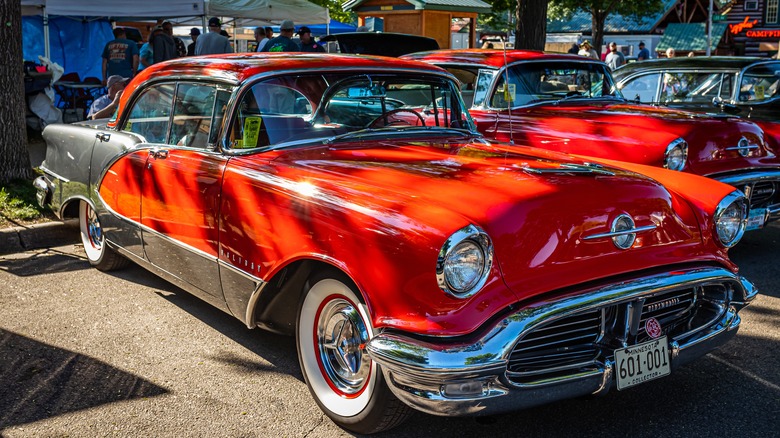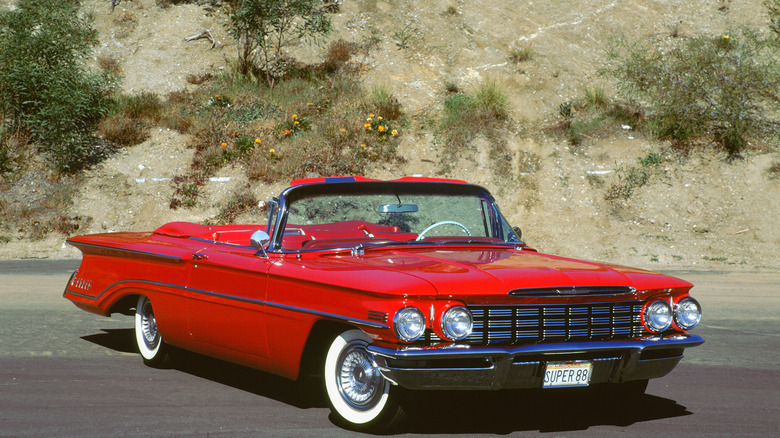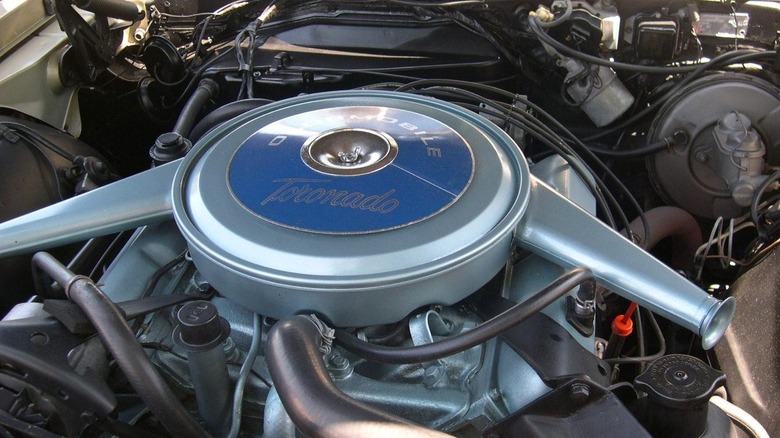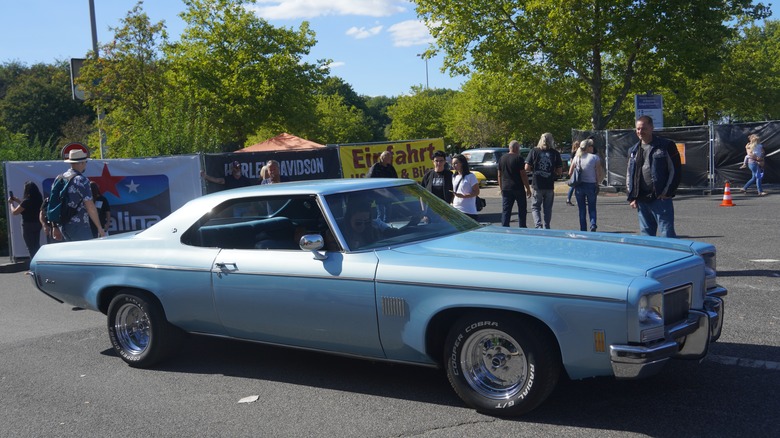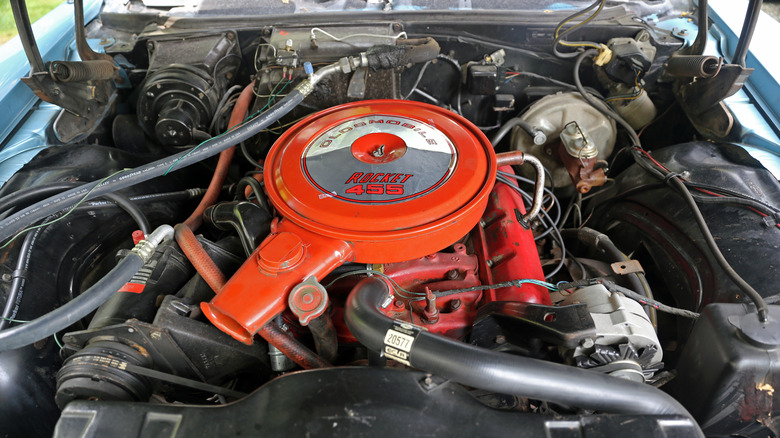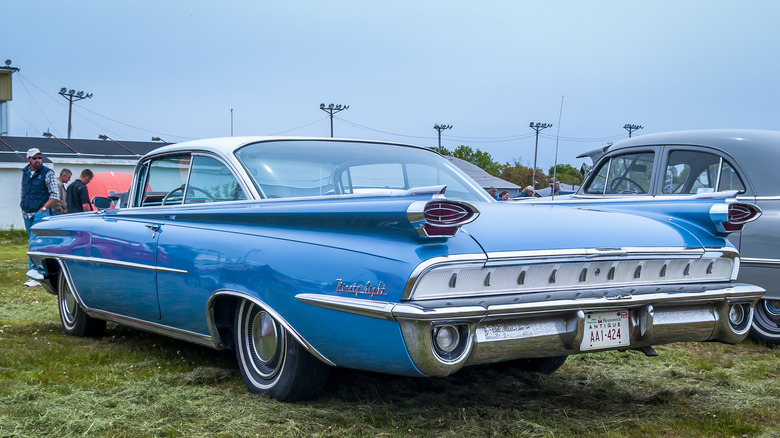5 Of The Best Engines Ever Put In An Oldsmobile
Oldsmobile was a big name in American cars from its beginning in 1897 until it closed in 2004. Besides making popular American Oldsmobile classics like the Jetfire and Toronado, the brand also made its fair share of notable engines. But when we talk about the "best" engines from Oldsmobile, we're looking at more than just speed and power. A truly great engine is reliable, advanced, and makes driving enjoyable. The story behind the engine and its legacy also plays a role, like how it was made and its impact on automotive history. These stories add to the engine's value and charm.
That said, we won't be ignoring performance and reliability — in fact, they just might be the two main things that made Oldsmobile engines a favorite for many enthusiasts over the years. In this look back at Oldsmobile's best engines, we'll see examples of top-notch engineering and some pretty interesting stories from the days of the '70s oil crisis. These are five of the best engines ever put in an Oldsmobile.
The Oldsmobile Rocket 88 V8 303
The Oldsmobile Rocket 88 V8, which debuted in 1949, was a big deal. In hindsight, you could argue it was the moment that ushered in the American muscle car era. This 5.0-liter engine, developed to fill a model gap in Oldsmobile's portfolio, was one of the earliest modern high-compression, overhead-valve V8s. Originally designed for the larger Oldsmobile 98 series, its placement in the lighter 88 series chassis resulted in a powerful combination that dominated the NASCAR circuit from its debut until 1952.
The Rocket was constructed from durable materials like steel and aluminum, featuring a 3.75-inch bore and a 3.438-inch stroke. It also had 135 horsepower and an impressive 253 lb-ft of torque — substantial figures for its era. These specs enabled the Rocket 88 to live up to its name, hitting a top speed of 97 mph and covering a quarter mile in 18 seconds. This performance not only excited racing fans but also "rocketed" sales by appealing to a post-war audience very eager for power and speed.
The engine's impact went beyond the track, too. The first generation powered several Oldsmobile models until 1953, notably the sporty Super 88, which had even more horsepower thanks to a four-barrel carburetor modification. This engine inspired designs across the General Motors portfolio, from Cadillac to Buick, and was even adapted for a variety of other purposes like irrigation pumps (funnily enough) and as a prototype diesel in GM research programs.
The Rocket V8 350
The Rocket 350 is another Oldsmobile engine that every American muscle fan should know about. Introduced in 1968, this engine quickly became popular thanks to its strong performance and reliability — an evolution of the lineage that began with the Rocket 88.
The Oldsmobile 350, designed mainly to generate great power from a small-block design, had a displacement of 350 cubic inches (5.7 liters) and was initially rated at up to 310 horsepower. A 10.25:1 compression ratio, a four-barrel carburetor, and high-flow cylinder heads all helped to make this possible. Production continued until 1980 with several changes in the 1970s, including adaptations for tougher emissions laws. Even with some horsepower losses throughout the years because of these tweaks, the 350 still managed to maintain its reputation for reliable power. The Rocket 350 was used in a wide range of Oldsmobile models in performance, family, and luxury categories, from the Toronado to the sporty Cutlass and the Delta 88.
Despite its success, the engine wasn't without problems. Common issues included a faulty oil system and problems with the valve train, which enthusiasts have frequently fixed with aftermarket parts and mods. Besides fixing the original flaws, these upgrades can also increase horsepower and torque as a side effect — good news for those looking for classic cars that make great project vehicles.
The Oldsmobile 403 V8
This engine, built from 1977 to 1979, didn't quite reach the legendary status of the Rockets but had many of the same specs as the 350. Like the 350, the Oldsmobile 403 V8 is a small block engine, but with a larger bore of 4.351 inches. It produced 185 horsepower and 320 pound-feet of torque. Despite its power, the engine had a low fuel efficiency, getting an estimated 12 miles per gallon in the city and 16 on the interstate.
The Oldsmobile 403 was distinguished by some unique features and, unfortunately, the problems it encountered. Its large bore was a double-edged sword, increasing the engine's power output while also creating cooling issues and the possibility of overheating. This was made worse by the emissions restrictions at the time, which required the use of restrictive heads with big combustion chambers and insufficiently small ports, limiting the engine's actual capacity.
The 403 V8 engine powered a wide range of General Motors cars. Some notable examples included the 1977 Oldsmobile Cutlass, the Delta 88, and even the GMC Motorhome. The Delta 88, in particular, became famous as the official pace car for the Indy 500 in 1977, officially earning the 403 a place in motorsport.
The Oldsmobile 455 V8
Introduced in 1968 as part of Oldsmobile's second-generation V8 engine line, the 455 was immediately adopted across a wide range of vehicles, and for good reason. Taking the "Rocket" name from its predecessor, this engine was a genuine giant with a displacement of 455 cubic inches (7.5 liters), and power outputs ranging from 310 to 400 horsepower. The most torque-heavy models produced an impressive 500 lb-ft, making the 455 a great choice for high-performance applications. It had a lengthy 4.25-inch stroke and a 4.126-inch bore, which contributed to its famous low-end torque.
The Oldsmobile 455 had more than just raw power. It also featured variable piston designs, compression ratios, and intake settings tailored to each vehicle's specific requirements. The engine's high-performance models, particularly the Hurst/Olds and 442 W30 package, had performance-enhancing improvements like forged connecting rods, aluminum pistons, and more aggressive camshaft profiles.
All that being said, the engine's performance quality declined in the early 1970s, owing mainly to, once again, tougher emission laws. By 1975, the once-mighty 455 had been considerably detuned. Despite this, the 455 V8 was still in production in various configurations until the end of the decade, powering some classic Oldsmobiles everyone forgot about like the Vista Cruiser and Custom Cruiser wagon. Several other vehicles benefited from this powerful engine, as well, the most notable being the Oldsmobile 442, which became a muscle car legend. The 455 also made its way into the Delta 88 and 98 luxury sedans.
The Oldsmobile Diesel V6
The Oldsmobile Diesel V8 and V6 engines, GM's ambitious attempt at diesel tech in the late 1970s, are some of the most interesting engines ever put in an Oldsmobile. Both engines deserve a chance at the spotlight — it's just that one has a really bad rap.
The LF9 type V8 was a pioneering diesel engine for passenger cars when it debuted in 1977. Contrary to popular belief, it wasn't simply a converted gasoline engine. It had some unique design aspects like a nickel-heavy iron casting for the block, nodular iron for the crank, and specially designed diesel pistons. The engine initially produced 120 horsepower and 220 lb-ft of torque, but its power was later lowered due to further modifications and environmental considerations.
Unfortunately, despite its unique design, the engine suffered from reliability issues like weak head bolts and insufficient water separation in the fuel, which were mostly due to rushed manufacture and cost-cutting tactics. In reaction to the problematic V8, Oldsmobile introduced the Diesel V6 in 1982, which addressed many of these flaws. This engine, although great, arrived too late to have a big impact on the market, as Oldsmobile's diesel reputation had already seriously degraded.
